Georgian Set Of Tool Or Lathe Sharpening Powders By Holtzapffel & Deyerlein
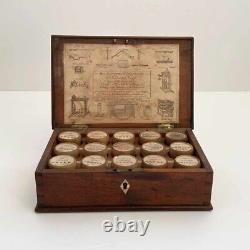

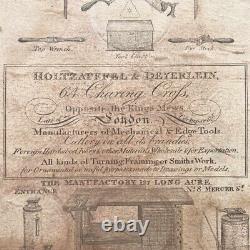
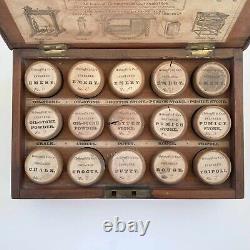
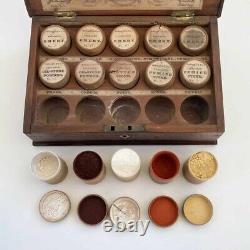
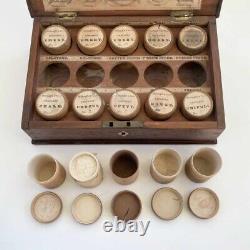
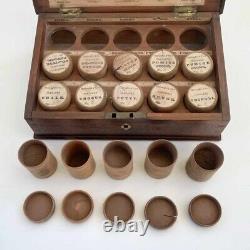

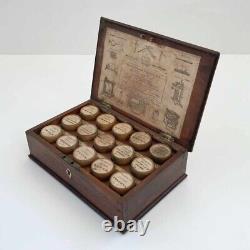


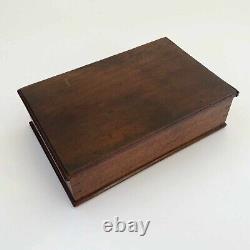

For sale, a unique set of George IV period tool or lathe sharpening powders by Holtzapffel & Deyerlein of Charing Cross London. Presented within a mahogany case with hinged lid bearing an original trade card for the makers, Holtzapffel & Deyerlein with centre section describing their business as follows.
Holtzapffel & Deyerlein, 64 Charing Cross opposite the King's Mews - Late of Cockspur Street, London. Manufacturers of Mechanical & Edge Tools, cutlery in all its branches, foreign hardwood & other materials wholesale and for exportation. All kins of turning, framing or smiths work, for ornamental or useful purposes made to drawings or models. The Manufactory 127 Long Acre, Entrance No, 8 Mercer Street.
Surrounding the central panel is a number of tools, lathes, grinding machines and even a portable forge which the company were marketing at this period. The contents of this rare surviving case are as follows. Back Row: Five different grits of emery ranging from 6 to 14. Middle Row: Two oil stone powders, two of pumice stone and one of rotten stone. Front Row: chalk, crocus, putty, rouge & Tripoli.
The tool making company of Holtzappffel & Deyerlein was originally formed by John Jacob Holtzapffel in 1794. He originated from Strasbourg but in 1792, Holtzapffel took up a position in the prestigious workshops of Jesse Ramsden in London. How his employment in the workshop of London's best scientific instrument making firm came to be remains a mystery but he must have already attained a high level of practical skill since he remained with the firm for just two short years before he left to establish a business alongside Francis Rousset, where records describe them as "mathematical turners". The company produced a wide range of goods in its early years with lathes, for which they ultimately became famous, being produced from 1795. The initial partnership was dissolved in 1803 and in 1804, Holtzapffel entered into a new partnership with his assistant, Johann Georg Deyerlein who had moved from Mannheim in Germany to England in 1789. The company's manufacturing works were initially based at 118 Long Acre but a fire destroyed their workshops in 1810, whereafter a new addresses at Cockspur Street, Charing Cross was established. This new address was presumably a retail premises as evidence of the trade card within this set still cites their manufactory at a new address of 127 Long Acre.The other address of 64 Charing Cross (opposite the King's Mews) was established in 1819 and to give you some indication of its position, the King's Mews was a Royal stables situated on the site which is now graced by the National Gallery and Trafalgar Square. It is of further interest to mention that Thomas Jones, another of Ramsden's acolytes also ran premises next door at number 62 Charing Cross so the pair would have been well acquainted. Deyerlein died in 1825 at the age of 59 and although the Holtzapffel name is perhaps the most well regarded, it is surprising to understand that Deyerlein was responsible for two patents for such diverse inventions as a brick making machine and improvements to weighing machines, giving an idea of the range and breadth of the company's productivity beyond their established tool and lathe making specialisms. In 1827, the company was changed to Holtzapffel & Co with the arrival of Holtzapffel's son.
Charles Holtzaffel is noted as having written numerous treatise and manuals in relation to ornamental turning which are still highly regarded. These publications helped cement the company's reputation for the production of superior lathes and accessories.
Sadly, the founder died in 1835 and his son Charles followed in 1847 leaving unpublished works on the subject. Without an heir old enough to continue the company, Charles's wife Amelia continued to manage the company while also completing her late husband's works and exhibiting at the numerous public exhibitions which began in 1851. Without her obvious business acumen, the Holtzapffel dynasty would have ended. Her son John Jacob II was, as a result, able to benefit from her efforts and finally became the head of the company which he ran until his death in 1896. His nephew George William Budd continued thereafter and ran the business successfully with his son until the onset of the Great War finally made business untenable.
This remarkably preserved set dates from the very earliest period of the company's history and can be reliably dated to between the company's move to Charing Cross in 1819 and up until the change of name upon Deyerlein's death in 1826. It is an extraordinary survivor given the nature of the contents and its use.
Their tools and lathes are extraordinarily rare but a consumable accessory such as this in complete condition is perhaps the only one of its kind remaining. Jason Clarke Antiques are happy to discuss carriage, condition or for any other queries, alternatively, you can also message us and we will endeavour to come back to you as soon as possible.

